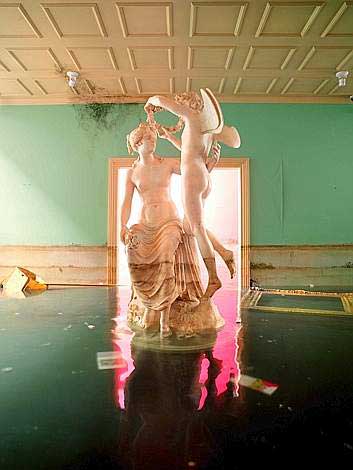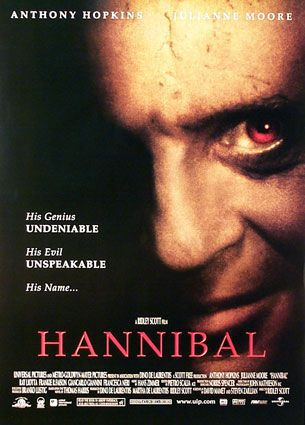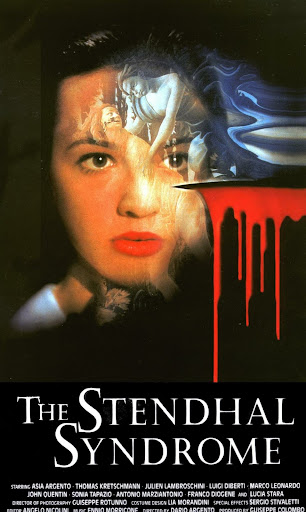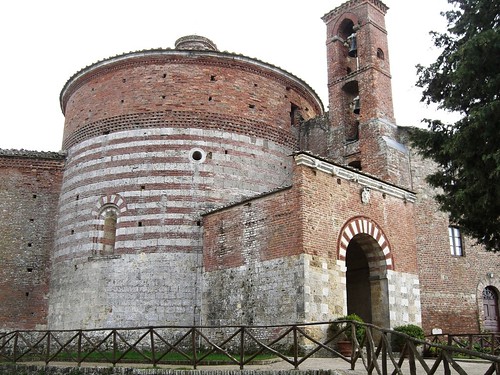Sunday, May 10, 2009
Hi people!
This blog was having some problems so I decided to move there
http://discoverflorence.blogspot.com
(just take off a "Y" from the url!)
please update your bookmarks and kinks!
My guide to tourism and travels in Florence, Tuscany

Hi people!
This blog was having some problems so I decided to move there
http://discoverflorence.blogspot.com
(just take off a "Y" from the url!)
please update your bookmarks and kinks!
Tags: Florence nearbies, museums, Vespa a 12:01 PM 4 comments
This is one of my favourite traditional dishes of Florence, the Florentine tripe (Trippa alla Fiorentina). It’s incredibly tasty, made with “poor” ingredients and it's a big part of the Tuscany popular and ancient tradional cusine.
Ingredients:
1 onion
1 carrot
1 stalk celery
extra-virgin olive oil
3 pounds tripe, blanched and boiled
1 pound canned peeled tomatoes.
Salt
Pepper
Parmigiano cheese
Use only the best parts of the tripe, and cut it into very thin strips.
Clean, wash and chop the onion, carrot and celery and put into a metal pan with olive oil. Cook well, then add the tripe.
When tripe gets golden in colour, add the tomatoes, chopped very finely.
Add salt and pepper, then cook over a very low heat for about half an hour, until the sauce has reduced almost completely, stirring frequently to prevent sticking.
The tripe may be served immediately when is still hot, sprinkled with some grated Parmigiano over.
Tripe is usually served with boiled or mashed potatoes or, if preferred, with cannellini beans and olive oil.

You can try this unique speciality in one of the several tripe stands (trippai) in the streets of the city.
Tripe stands are generally open from 8:30 or 9 a.m. to 6:30 or 7:30 p.m. some of them even on Saturdays.
Some addresses:
Mario Albergucci, Piazzale di Porta Romana.
Sergio Pollini, Via dei Macci (near Borgo La Croce).
Il Trippaio di Firenze, Via Maso Finiguerra.
Marco Bolognesi, Via Gioberti.
Trippaio, Via Dante Alighieri.
Nerbone (inside San Lorenzo Market, 011-39- 055-219-949).
Tags: Florence, food, recipes, restaurants, traditions a 8:22 AM 3 comments
Here’s a list of the best vintage shops in Florence: here you can find clothing, jewellery, handbags, shoes and more, from the twenties to the eighties, and you can also find some incredible vintage masterpieces of the best Italian super-fashion griffes, as Gucci or Armani...
Don't forget to hang around piazza Ciompi flea market too!
Pitti Vintage – vintage clothing and accessories
Sdrucciolo dei Pitti 19/R
Florence, Italy
50125
Phone: +(39) 055 230 2676
http://www.pittivintage.com/
Beggar Len – vintage clothing
via R. Giuliani 106/R
Florence, Italy
50100
Phone: + (39) 055 417 028
+(39) 335 543 0252
http://www.beggarlen.com/
Anna – vintage jewellery (from twenties to eighties)
Borgo Allegri
50100 Firenze
Pennylane – vintage clothing and accessories (sixties and seventies)
Via Verdi 53/R
50100 Firenze
Phone: +(39) 055 248 0498
http://www.pennylanevintage.com/
Officina Vintage – vintage clothing and accessories
Boutique
Via del Giglio 41/R
50100 Florence (historical center)
Tel. +(39) 055 215 828
http://www.officina-vintage.com/
Showroom
Via F. Botticini 20
50143 Florence (Legnaia zone)
Tel./Fax +(39) 055 719 1340
Nadine Shop – vintage griffes clothing and accessories (Pierre Cardin, Balenciaga, Chanel, Dior, Hermes, Gucci, Fendi, Ferragamo, Valentino, Pucci, Saint Laurent...)
Lungarno Acciaiuoli, 22/R
50123 Firenze
Tel.: (+39) 055 287 851
http://www.boutiquenadine.it/
Tags: Blogger Guides, Bloggers Guides, Florence, shopping a 9:31 AM 2 comments
 From February 28 2009 To May 06 2009 the Galleria Poggiali e Forconi in Florence will house an exhibition by David LaChapelle.
From February 28 2009 To May 06 2009 the Galleria Poggiali e Forconi in Florence will house an exhibition by David LaChapelle.
After 10 years the world-famous photographer of celebrities David LaChapelle is back in Florence with a great free exhibition of his works.
The David LaChapelle exhibition is divided into four main sections: Deluge, Recollections in America, Star System and Heaven to Hell.

Tags: art, Blogger Guides, Bloggers Guides, events, exhibitions, Florence, museums a 8:42 AM 0 comments
Here is my top ten tips to save some euros when visiting Florence: it's quite an expensive city for Italian standards, so let's pay attention to our wallet!
1 – save some money using the bus instead of taxi to move in Florence. Buy multiple tickets or “Carta Agile” to get 10 bus rides at the price of 8… and walk if you can, it’s free!
2- if you’re gonna visit several museums buy inclusive and multiple tickets.
3- Don’t book your visits, it usually has a charge. to avoid long waiting lines just wake up early and go in the early morning ;-)
4 – if you want to do wild shopping and you’re looking for the great Italian fashion brands, go to the outlets, the surroundings of Florence are full of outlets! (see this post for more info about Florence outlets!).
5 - take advantage of the sales: the best are in January-February and August-September. At the end of the sale season you can find up to 70% sales.
6- avoid pubs, restaurants and bars in the historical centre, they’re much expensive than the ones located in the other city neighbourhoods.
7 - Go to Happy Hours (from 18.30 to 20.00) to get drinks for less and to eat something for free.
8 – buy fresh and typical food in markets instead of shops, it’s surely cheaper and usually even the quality of products is better.
9 – if you have a car, don’t even try to drive or park in the historical (unless you have the microchip card) centre or park where’s forbidden: you’ll soon get a collection of fines, and Italian police won’t leave you in peace until you pay them, even if you live abroad.
10 – get information about special days and offers: 2 euro discount on cinemas on Wednesday, discount on museums tickets on special days, student fees (especially for architecture, arts and history students), special fees for groups.
An extra tip to save money: when you're booking your holiday in Florence use Trivago, compare the prices of the best hotels and find the best deal!
Here are three movies that I really like: all those films had been shot in Florence, and that’s the only thing that they have in common! Different genres, different years, different styles… but all those movies represent an atmosphere, an aspect of Florence, and put the spotlight on some of the million different sides that this wonderful city can offer to the observer.
Hannibal (2001)
Directed by Ridley Scott
Starring: Anthony Hopkins, Julianne Moore, Gary Oldman, Ray Liotta, Giancarlo Giannini, Zeljko Ivanek, Frankie Faison, Francesca Neri.
Music by Hans Zimmer.



1 . Pizza, bread and pastries at Pugi, the best bakery in Florence. You can find Pugi at:
P.zza S. Marco 10
Tel. 055 280981
Via S. Gallo 62/R
Tel. 055 475975
Viale De Amicis 49/R
Tel. 055 669666
2 . Meat! Big bloody steaks, that’s the masterpiece of Florence, and I love it!
3 . Celebrations for San Lorenzo day (saint Lawrence), June 24th. Huge fireworks and lots of people in the streets.
4 . My bike. Forget your car in Florence, if you don’t want to waste time in traffic jams use bus, bikes or feet!
5 . Air conditioning. Summer in Florence is incredibly hot...
6. Shopping and hanging around in the city markets. My favourite one is Sant’Ambrogio: fruits and vegetables, meat, clothing, shoes, books, and more…
7 . Rock Bottom Records Shop. Here I buy food for my soul: a great selection of rock ‘n’ roll, beat, garage, punk, vinyl records, both new and second-hand, at reasonable prices.
8 . A compact umbrella, the one you can store in a bag. When it starts to rain, it could last forever :-(
9 . Sales! Fashion! Shopping! Sales in Florence are a jungle but I’m a beast!
10 . A cup of tea or a cappuccino with my friends at the Caffè La Loggia in via Pietrapiana.
Tags: Blogger Guides, Florence, Florence rants, Florence Tour, food, markets, nightlife, shopping, top 10 a 12:23 PM 3 comments

Tags: Blogger Guides, churches, events, Florence, traditions a 9:43 AM 3 comments
 Tripe (Trippa)
Tripe (Trippa)Lampredotto
The best lampredottaio in Florence are:
- Piazza de’ Cerchi (near Piazza della Signoria)
- Via Gioberti (near Piazza Beccaria)
- Piazza di Mercato Nuovo (Mercato del Porcellino)
- San Lorenzo Market (the stand is called “Nerbone”)
- Via del Verrocchio (behind Sant’Ambrogio market)

Tags: Blogger Guides, Florence, food, restaurants, traditions, tuscany a 3:17 AM 4 comments
When you have an holyday in Florence an entire year wouldn’t be enough to see all the beautiful thing of Florence.
Here’s a Decalogue of the most important cultural and architectural issues that you can’t really miss in your trip to Florence: the most important museums, churches, and suggestive corners of the city.
If you are well organized you can see all those things in about 4 intensive days.
1- Uffizi museum – masterpieces of Botticelli, Giotto, Cimabue, Masaccio, Leonardo da Vinci, Michelangelo, Donatello and many others.
2- Palazzo Pitti- it houses several minor collections in addition to those principal of the Medici family.
3- Piazzale Michelangelo – an incredibly beautiful panoramic view of Florence from the hillside, and a wonderful roman church nearby, San Miniato al Monte.
4- Market of San Lorenzo – the city market, with clothings, leather goods, typical food…
5- Galleria dell’Accademia and Michelangelo’s David… the masterpiece of Michelangelo, the statue of David, it’s here!
6- Cathedral of Santa Maria del Fiore – the cathedral of Florence, with the magnificent Brunelleschi dome.
7- Ponte Vecchio – how romantic! A bridge over the Arno river, sided with small ancient buildings which house traditional jewelery shops.
8- Oltrarno – a typical old neighbourhood with traditional shops, small hidden streets and beautiful fiorentine houses.
9- Santa Maria Novella church – a wonterful example of the early italian gothic style, that’s my favorite church!
10- Piazza della Signoria – probably the most famous view of Florence, with Palazzo Vecchio facing the square.
the cloister and garden of the museum
Here is exposed the ancient and famous Map of the Chain (“la pianta della catena”), called in that way it has a frame decorated with a chain.
It’s really not a plant… is not more a general view Florence, an axonometric projection realized at the end of 1400, and is really big, it takes the entire wall.
It’s so beautiful and painted with an incredible care for details; above all it’s a witness of how looked Florence during the renaissance: a densely inhabited large city, still with cultivations out of the town-walls, encircled from its walls studded with doors. Every single palace and church are faithfully reproduced and clearly recognizable: Palazzo Vecchio Santa Maria Novella, the Cathedral… Arno river slides and is still a city fulcrum of people and activity: you can see people on the riverside fishing, bathing, building a bridge…
the Map of the Chain ("Pianta della Catena")
Besides the Plant of the Chain the museum conserve some other ancient pieces: the keys of the doors of the city: the ones of Porta San Frediano, Porta Santo Spirito and Porta San Gallo, enormous keys with their leather bags; they were of property of a private collector, once he died the keys were given back to the city of Florence.
Others ancient maps and city representation of Florence are exposed in the museum. There are also paintings, that show various parts of the city and how they changed through the centuries. A beautiful painting that shows the public execution of Girolamo Savonarola in the Piazza dell Signoria.
the keys of the doors of Florence
the plastic of the hystorical center bofore '800
In the second room of the museum are shown some archaeological artefacts found in the eighties, when piazza della Signoria had been re-pavemented: finally we can see some traces of the ancient roman Florence. The artefacts are few but interesting, and you can also find a really interesting plastic of Florence as it was in the roman age.
the plastic of Florence in the Roman Age
Tags: archaelogy, Blogger Guides, Florence, museums a 10:08 AM 2 comments
 The Piazzale Michelangelo is surely one of the most beautiful places to visit in Florence Italy. Placed high on a green hillside overlooking the city, visitors can enjoy a breathtaking view of the whole city: you can spot the duomo, Palazzo Vecchio with its tower, Giotto’s bell-tower, the Arno river that flows and tear the city in two parts, with its bridges in sequence.
The Piazzale Michelangelo is surely one of the most beautiful places to visit in Florence Italy. Placed high on a green hillside overlooking the city, visitors can enjoy a breathtaking view of the whole city: you can spot the duomo, Palazzo Vecchio with its tower, Giotto’s bell-tower, the Arno river that flows and tear the city in two parts, with its bridges in sequence. Piazzale Michelangelo was built in 1869 and designed by architect Giuseppe Poggi, when Florence became the capital city of Italy (for a short period) and needed big, magnificent public spaces to represent the power of the newborn Reign of Italy.
Piazzale Michelangelo was built in 1869 and designed by architect Giuseppe Poggi, when Florence became the capital city of Italy (for a short period) and needed big, magnificent public spaces to represent the power of the newborn Reign of Italy. San Miniato al Monte
San Miniato al Monte


Tags: architecture, Blogger Guides, churches, Florence a 10:39 AM 1 comments
The construction of the Duomo, the Cathedral also called Santa Maria del Fiore, was started by Arnolfo di Cambio on the 8th September 1296. It is the fourth longest church in the world (after Saint Peter in Rome, Saint Paul in London and the Cathedral in Milan). In some experts' opinion, Arnolfo's project was quite different from the present building, but the outside walls undoubtedly are the same as those in the original plan. When Arnolfo died in 1310, there was a delay in the works. They however were started again in 1331, when the Guild of Wool Merchants took over the construction of the church. In 1334 Giotto was appointed ‘master’ of the works. He mainly attended to the building of the campanile (bell tower) and died three years later. There were several interruptions until 1367, when a competition was held and a final model for the church by four architects and four painters was accepted. The vault of the nave was finished in 1378 and the aisles were completed in 1380.
Between this year and 1421 the tribunes and probably the drum of the dome were built. The octagonal dome, consisting of two concentric shells linked together, was completed in 1434. A competition was held for the dome in 1418 and, after many doubts, Filippo Brunelleschi's project was accepted in 1420. The church, dedicated to Santa Maria del Fiore (fiore referring to Florence) was consecrated on the 25 of March, 1436.
The remarkable differences in the various parts of the Cathedral show the evident changes in taste during the long time passed between the foundation of the church and its completion. Outside the shape of the round blind arches is a Romanesque vestige. The whole interior, with its huge arches, doors and windows, is Gothic . The dome is a masterpiece of the Renaissance. The façade, though in Gothic style, is from the 19th century. On the north side of the Cathedral, the Porta della Mandorla, dating from the 15th century, shows a Gothic influence both in the architectural design and decoration.
Tags: architecture, Blogger Guides, churches, duomo, Florence a 2:05 PM 6 comments
I took these pictures of Florence Cathedral (Santa Maria del Fiore) in a bright fresh morning of June 2008, just after a thick but quick rain, the air was clean and the sky was so bright... the big red silhouette of the dome was making a perfect contrast with the blue of the sky.
Tags: architecture, Blogger Guides, churches, Florence a 2:52 PM 4 comments






Tags: Blogger Guides, churches, legends, tuscany a 10:50 AM 9 comments



Tags: architecture, Blogger Guides, Florence, museums a 2:54 AM 4 comments